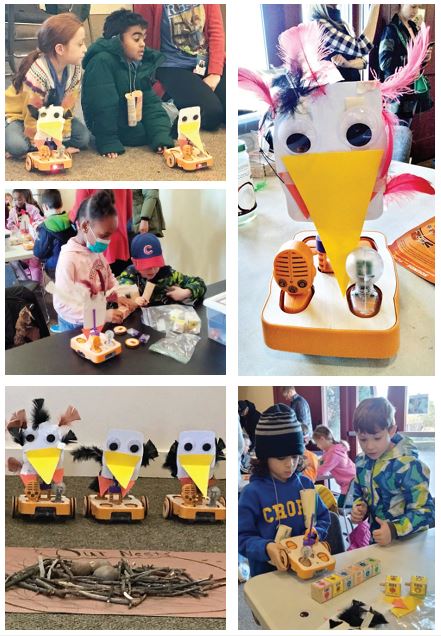NSTA: From Birding to Robotics: Integrating STEM Learning Through Community Collaboration
In this article in National Science Teaching Association‘s Connected Science Learning publication, Professor Katie Blagden, from Roger Williams University, shares how she, and her in in service teachers combined robotics, bird watching, research and art at the Audubon Society of Rhode Island. What an amazing, creative use of KIBO!

“This article exemplifies the transformative power of community collaboration, as STEM education meets real-world, hands-on life science, inspiring the next generation of young minds to “soar” to new heights. This project combines the wonders of birding with the limitless possibilities of robotics, igniting a spark of excitement in STEM education. This study investigates the effectiveness of connecting integrated STEM learning with nature-based experiences, with the ultimate goal of enriching elementary students’ learning and extending their knowledge of integrated STEM topics.”
The article reads in part
“I currently teach a coding course for preservice teachers where we use many types of robotics, including a variety of screen-free robots. The screen-free KIBO robots we used for this collaborative project were specifically created for education settings and do not require a screen. Students program the KIBO robot by creating sequences of wooden blocks with scannable barcodes that correspond to programming commands such as forward, backward, turn, and repeat. Students then use the body of the KIBO robot itself to scan their block sequences to have the robot act out their programs. The top of the KIBO robot has a platform for students to build on, so they can make it into any character, animal, or vehicle that they choose. The array of interactive sensors and extensions, which include dark/light sensors, sound sensors, recording devices, lightbulb attachment extensions, and distance sensors, are easily coded and manipulated by young students. Preschoolers can find success with simple commands, while older students can design more complex sequences.
For my service learning project, my goal was to give elementary students the opportunity to connect the learning they are doing in school to STEM experiences outside of school, incorporating robotics and coding while meeting the second-grade NGSS science standards. I also aimed to give preservice teachers the opportunity to not only practice writing lessons with technology integration, but also use these robots with young children to build experience and confidence in integrating STEM into the elementary curriculum.”
Conclusions Found
“Integrating STEM—specifically outdoor, place-based learning, and coding and robotics—into the elementary classroom is beneficial for the students, educators, and community members involved. The elementary grades are an important time for students’ skills and interests to develop. The integration of STEM into the elementary curriculum will enhance student learning and engagement through the highly motivating interactions with real-world science and integrated with robotics and coding. Results from qualitative and quantitative data showed that the elementary students, preservice teachers, and community members from the nature center and the local robotics company involved in this project greatly benefited from the positive impact this integrated STEM program created.
This project also illustrates the power of collaboration within a community. Connecting with experts can give preservice and inservice educators the confidence to teach STEM in their own classrooms. And, involving inservice educators helps to ensure that these STEM learning experiences are relevant and connected to classroom learning. With the common goal of connected integrated STEM for elementary students, long-lasting partnerships were formed to create a significant impact on our community. I believe that, with some planning, any school, district, university, or local organization could follow our blueprint to integrate robotics, STEM, and local partners to benefit students in their own communities.”
Read the full article and findings.



















